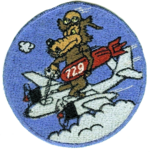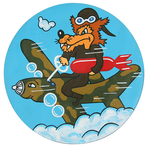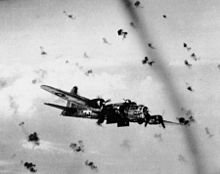729th Airlift Squadron
| 729th Airlift Squadron
Republic of Vietnam Gallantry Cross with Palm[1] | |
|---|---|
| Insignia | |
| 729th Airlift Squadron emblem[a][1] |  |
| 729th Military Airlift Sq emblem[b][1] |  |
| Unofficial 729th Bombardment Squadron emblem (B-26 era) |  |
| 729th Bombardment Squadron emblem[c][2] |  |
| World War II fuselage code[3][d] | M3 |
| Aircraft flown | |
| Transport | C-17 Globemaster III |
The 729th Airlift Squadron is a
The squadron was first activated as the 729th Bombardment Squadron in 1943. After training in the United States with the
The squadron was activated again in the
The squadron was activated in the reserves again two months later as the 729th Tactical Reconnaissance Squadron. It returned to the light bomber mission in 1955, but the Air Force's reserve units were converting to the airlift mission, and the squadron became the 729th Troop Carrier Squadron in July 1957, and has served in tactical and strategic airlift roles since then.
History
World War II

The
The squadron established itself at
The 729th was occasionally diverted to support tactical operations. It hit
Shortly before the end of the war, on 7 April, the squadron struck the
After
Reserve duty and Korean War call-up

The squadron was reactivated in the
The squadron was mobilized for the
The unit moved to
On 23 March 1951, the squadron led troop carrier aircraft carrying the
Reconnaissance and Bombardment in the reserves
The squadron was redesignated the 729th Tactical Reconnaissance Squadron and activated in June 1952 at Long Beach, where it absorbed some of the resources of the 921st Reserve Training Wing, which was inactivated. The reserve mobilization for the Korean War, however, had left the reserve without aircraft, and the unit did not receive aircraft until July 1952.
In 1955, the squadron once again became the 729th Bombardment Squadron and trained with the Invader as a tactical bombardment unit.[16] However, at this time, the Joint Chiefs of Staff were pressuring the Air Force to provide more wartime airlift. At the same time, about 150 Fairchild C-119 Flying Boxcars became available from the active force. Consequently, in November 1956 the Air Force directed Continental Air Command (ConAC) to convert units to the troop carrier mission by September 1957.[17] In July 1957, the squadron became the 729th Troop Carrier Squadron.[1]
Tactical airlift
As a troop carrier squadron the unit transitioned to the C-119 and flew them from Long Beach until reserve flying operations there ended in the fall of 1960 and the
Activation of groups under the wing
Since 1955, the Air Force had been detaching Air Force Reserve squadrons from their parent wing locations to separate sites. The concept offered several advantages: communities were more likely to accept the smaller squadrons than the large wings and the location of separate squadrons in smaller population centers would facilitate recruiting and manning. In time, the detached squadron program proved successful in attracting additional participants.
In March 1968, the squadron moved to Norton Air Force Base, California, but it would only fly C-119s from Norton for a year.[1]
Strategic airlift
By 1968 regular air force military airlift squadrons were operating the
In August 1992, Air Force Reserve Command reorganized its flying wings under the Objective Wing model. The squadron, along with the other flying squadrons of the 445th Wing, was assigned to the reactivated 445th Operations Group. As a result of the closure of Norton as part of the United States Department of Defense's 1988 Base Realignment and Closure Commission program, on 14 August 1993, the 729th returned to March Air Force Base, where it was assigned to the 452d Operations Group and once more operated its own planes. The 729th was renamed the 729th Airlift Squadron on 1 February 1992.[1][16] The squadron retired its C-141 Starlifter fleet in 2005.[22]
On 9 August 2005 the wing received its first Boeing C-17 Globemaster III strategic airlifter, named "Spirit of California". This was the first of nine C-17s assigned to the 452nd, the wing became the first Air Force Reserve Command C-17 Globemaster III unit.[23]
Lineage
- Constituted as the 729th Bombardment Squadron (Heavy) on 14 May 1943
- Activated on 1 June 1943
- Redesignated 729th Bombardment Squadron, Heavy on 20 August 1943
- Inactivated on 28 August 1945
- Redesignated 729th Bombardment Squadron, Very Heavy on 13 May 1947
- Activated in the reserve on 12 July 1947
- Redesignated 729th Bombardment Squadron, Light on 27 June 1949
- Ordered to active service on 10 August 1950
- Redesignated 729th Bombardment Squadron, Light, Night Intruder on 25 June 1951
- Relieved from active service and inactivated on 10 May 1952
- Redesignated 729th Tactical Reconnaissance Squadron on 6 June 1952
- Activated in the reserve on 13 June 1952
- Redesignated 729th Bombardment Squadron, Tactical on 22 May 1955
- Redesignated 729th Troop Carrier Squadron, Medium on 1 July 1957
- Redesignated 729th Tactical Airlift Squadron on 1 July 1967
- Redesignated 729th Military Airlift Squadron (Associate) on 25 April 1969
- Redesignated 729th Airlift Squadron (Associate) on 1 February 1992
- Redesignated 729th Airlift Squadron on 1 April 1993[1]
Assignments
- 452d Bombardment Group, 1 June 1943 – 28 August 1945
- 452d Bombardment Group, 12 July 1947 – 10 May 1952
- 452d Tactical Reconnaissance Group (later 452d Bombardment Group, 452d Troop Carrier Group), 13 June 1952
- 452d Troop Carrier Wing, 14 April 1959
- 943d Troop Carrier Group (later 943 Tactical Airlift Group), 17 January 1963
- 944th Military Airlift Group, 25 April 1969
- 445th Military Airlift Wing, 1 July 1973
- 445th Operations Group, 1 August 1992
- 452d Operations Group, 1 May 1994 – present[1]
Stations
|
|
Aircraft
|
|
Awards and campaigns
| Award streamer | Award | Dates | Notes |
|---|---|---|---|
Distinguished Unit Citation |
7 April 1945 | Germany 729th Bombardment Squadron[1] | |
| Distinguished Unit Citation | 9 July-27 November 1951 | Korea 729th Bombardment Squadron[1] | |
| Distinguished Unit Citation | 28 November 1951-30 April 1952 | Korea 729th Bombardment Squadron[1] | |
Air Force Outstanding Unit Award |
1 July 1970-30 June 1971 | 729th Military Airlift Squadron[1] | |
| Air Force Outstanding Unit Award | 1 September 1985-31 August 1987 | 729th Military Airlift Squadron[1] | |
| Air Force Outstanding Unit Award | 1 September 1995-31 August 1996 | 729th Airlift Squadron[1] | |
| Air Force Outstanding Unit Award | 1 September 1997-31 August 1999 | 729th Airlift Squadron[1] | |
| Air Force Outstanding Unit Award | 1 October 2002–30 September 2004 | 729th Airlift Squadron[1] | |
| Air Force Outstanding Unit Award | 1 October 2004–30 September 2006 | 729th Airlift Squadron[1] | |
| Air Force Outstanding Unit Award | 1 October 2006–30 September 2008 | 729th Airlift Squadron[1] | |
| Air Force Outstanding Unit Award | 1 October 2008–30 September 2010 | 729th Airlift Squadron[1] | |
Korean Presidential Unit Citation |
27 October 1950-27 October 1951 | 729th Bombardment Squadron[1] | |
Vietnamese Gallantry Cross with Palm |
25 July 1968-28 January 1973 | 729th Tactical Airlift Squadron (later 729th Military Airlift Squadron)[1] |
| Campaign Streamer | Campaign | Dates | Notes |
|---|---|---|---|
| Air Offensive, Europe | 8 January 1944 – 5 June 1944 | 729th Bombardment Squadron[1] | |
| Air Combat, EAME Theater | 8 January 1944 – 11 May 1945 | 729th Bombardment Squadron[1] | |
| Normandy | 6 June 1944 – 24 July 1944 | 729th Bombardment Squadron[1] | |
| Northern France | 25 July 1944 – 14 September 1944 | 729th Bombardment Squadron[1] | |
| Rhineland | 15 September 1944 – 21 March 1945 | 729th Bombardment Squadron[1] | |
| Ardennes-Alsace | 16 December 1944 – 25 January 1945 | 729th Bombardment Squadron[1] | |
| Central Europe | 22 March 1944 – 21 May 1945 | 729th Bombardment Squadron[1] | |
| CCF Intervention | 3 November 1950 – 24 January 1951 | 729th Bombardment Squadron[1] | |
| 1st UN Counteroffensive | 25 January 1951 – 21 April 1951 | 729th Bombardment Squadron[1] | |
| CCF Spring Offensive | 22 April 1951 – 9 July 1951 | 729th Bombardment Squadron[1] | |
| UN Summer-Fall Offensive | 9 July 1951 – 27 November 1951 | 729th Bombardment Squadron[1] | |
| Second Korean Winter | 28 November 1951 – 30 April 1952 | 729th Bombardment Squadron[1] | |
| Korea Summer-Fall 1952 | 1 May 1952 – 10 May 1952 | 729th Bombardment Squadron[1] |
See also
- List of A-26 Invader operators
- List of United States Air Force airlift squadrons
- B-17 Flying Fortress units of the United States Army Air Forces
References
Notes
- Explanatory notes
- ^ Modified 2 May 1995.
- ^ Approved 29 April 1980.
- ^ Approved 1 October 1943. Description: On a light blue disc, a caricatured tan wolf, wearing flight suit and helmet brown, riding astride of a flying fortress camouflaged green and brown, grasping white steering wheel in right forepaw, and holding red aerial bomb under left forepaw, all between small white cloud formation in dexter chief and large white cloud formation in sinister base and emitting white speed lines to rear.
- ^ The squadron did not use this code until the end of the war, although it had been assigned earlier. Instead, the squadron's aircraft only carried the individual aircraft letter, preceded by a bar. Freeman, p. 289.
- ^ Aircraft in foreground is Douglas B-26B-61-DL Invader
- ^ Robertson indicates the training began in 1949. Robertson, Factsheet 729 Airlift Squadron. Maurer, however, indicates that B-26 training did not begin until 1950. Maurer, Combat Squadrons, p. 725.
- 437th Troop Carrier Wing.
- ^ Under this plan flying squadrons reported to the wing Deputy Commander for Operations and maintenance squadrons reported to the wing Deputy Commander for Maintenance.
- Citations
- ^ a b c d e f g h i j k l m n o p q r s t u v w x y z aa ab ac ad ae af ag ah ai aj ak al am an ao ap Robertson, Patsy (26 November 2012). "Factsheet 729 Airlift Squadron (AFRC)". Air Force Historical Research Agency. Retrieved 23 October 2016.
- ^ Maurer, Combat Squadrons, pp. 724–725
- ^ Freeman, p. 289
- ^ a b c d e Maurer, Combat Units, pp. 326–328
- ^ a b Freeman, p. 258
- ^ Freeman, p. 188
- ^ "Abstract, History 416 AAF Base Unit Jan–Mar 1945". Air Force History Index. Retrieved 7 May 2017.
- ^ "Abstract, History 2347 Air Force Reserve Training Center Jul–Sep 1950". Air Force History Index. Retrieved 7 May 2017.
- ^ Cantwell, p. 74
- ^ Cantwell, p. 92, Maurer, Combat Units, pp. 522–523
- ^ Cantwell, p. 93
- ^ a b Endicott, pp. 69–70
- ^ Cantwell, p. 103
- ^ See Maurer, Combat Squadrons, p. 175 (simultaneous activation at Pusan)
- ^ Cantwell, p. 139
- ^ a b c d e Robertson, Patsy (22 June 2017). "Factsheet 452 Air Mobility Wing (AFRC)". Air Force Historical Research Agency. Retrieved 1 July 2020.
- ^ Cantwell, p. 168
- ^ Cantwell, p. 163
- ^ Cantwell, p. 156
- ^ a b Cantwell, pp. 189–191
- ^ Cantwell, p. 210
- ^ Proeitti, MSG Matt (14 December 2007). "War's end meant 452nd's demise . . . for 20 months". 452nd Air Mobility Wing Public Affairs. Retrieved 29 March 2020.
- ^ "March accepts AF Reserve Command's first C-17". Retrieved 29 March 2020.
- ^ Station number in Anderson.
- ^ Station number in Endicott.
- ^ Station information in Robertson, 729 Airlift Squadron Factsheet, except as noted.
- ^ Dougherty, TSG Thomas P. (9 August 2005). "Air Force Reserve welcomes its first unit-equipped C-17 Globemaster III". Air Force Reserve Command Public Affairs. Retrieved 29 March 2020.
Bibliography
![]() This article incorporates public domain material from the Air Force Historical Research Agency
This article incorporates public domain material from the Air Force Historical Research Agency
- Anderson, Capt. Barry (1985). Army Air Forces Stations: A Guide to the Stations Where U.S. Army Air Forces Personnel Served in the United Kingdom During World War II (PDF). Maxwell AFB, AL: Research Division, USAF Historical Research Center. Archived from the original (PDF) on 23 January 2016. Retrieved 7 July 2012.
- Cantwell, Gerald T. (1997). Citizen Airmen: a History of the Air Force Reserve, 1946–1994. Washington, D.C.: Air Force History and Museums Program. ISBN 0-16049-269-6. Retrieved 17 December 2016.
- Endicott, Judy G., ed. (2001). The USAF in Korea, Campaigns, Units and Stations 1950-1953 (PDF). Maxwell AFB, AL: Air Force Historical Research Agency. ISBN 0-16-050901-7. Retrieved 17 December 2016.
- ISBN 978-0-87938-638-2.
- Maurer, Maurer, ed. (1983) [1961]. Air Force Combat Units of World War II (PDF) (reprint ed.). Washington, DC: Office of Air Force History. LCCN 61060979.
- Maurer, Maurer, ed. (1982) [1969]. Combat Squadrons of the Air Force, World War II (PDF) (reprint ed.). Washington, DC: Office of Air Force History. OCLC 72556.
- Ravenstein, Charles A. (1984). Air Force Combat Wings, Lineage & Honors Histories 1947-1977. Washington, DC: Office of Air Force History. ISBN 0-912799-12-9.
- Watkins, Robert (2008). Battle Colors: Insignia and Markings of the Eighth Air Force in World War II. Vol. I (VIII) Bomber Command. Atglen, PA: Shiffer Publishing Ltd. ISBN 978-0-7643-1987-7.


